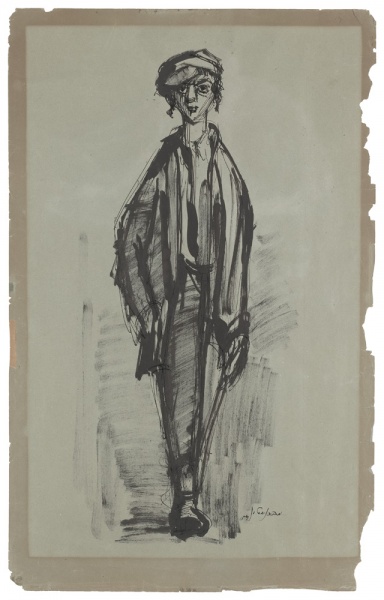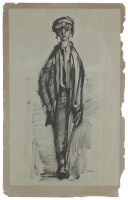
The Jewish boy (recto). The Jewish boy (verso)
| Author: | Moshe Bernstein (1920–2006) |
Moshe Bernstein (b. 1920 Bereza Kartuska, Belarus – d. 2006 Tel Aviv) was born into a religious family in a small shtetl, after finishing cheder Moshe Bernstein studied in the Art Department at Stephen Báthory University in Vilnius until 1939. He did not paint much, and mostly made pen and ink drawings and illustrated books of poetry. On the outbreak of the Second World War he moved to Białystok, but the Nazis started rounding up Jews there too and sending them to the ghetto. Bernstein managed to escape to Russia and ended up after an arduous journey on a kolkhoz near Saratov, where he found a job as a graphic designer, drawing propaganda posters and writing patriotic slogans. In 1947 he returned to his home town to find that his entire family had been killed. He emigrated to Israel in 1948, and held his first solo exhibition in Tel Aviv the following year. He later exhibited his work in Israel regularly, and held exhibitions in Amsterdam, Paris, Parma and Caracas.
Source: Ellex Valiunas (LAWIN until 2015) art album: STORIES OF LITVAK ART (2023). Compiler and author Vilma Gradinskaitė.

Moshe Bernstein (b. 1920 Bereza Kartuska, Belarus – d. 2006 Tel Aviv) was born into a religious family in a small shtetl, after finishing cheder Moshe Bernstein studied in the Art Department at Stephen Báthory University in Vilnius until 1939. He did not paint much, and mostly made pen and ink drawings and illustrated books of poetry. On the outbreak of the Second World War he moved to Białystok, but the Nazis started rounding up Jews there too and sending them to the ghetto. Bernstein managed to escape to Russia and ended up after an arduous journey on a kolkhoz near Saratov, where he found a job as a graphic designer, drawing propaganda posters and writing patriotic slogans. In 1947 he returned to his home town to find that his entire family had been killed. He emigrated to Israel in 1948, and held his first solo exhibition in Tel Aviv the following year. He later exhibited his work in Israel regularly, and held exhibitions in Amsterdam, Paris, Parma and Caracas.
Source: Ellex Valiunas (LAWIN until 2015) art album: STORIES OF LITVAK ART (2023). Compiler and author Vilma Gradinskaitė.






